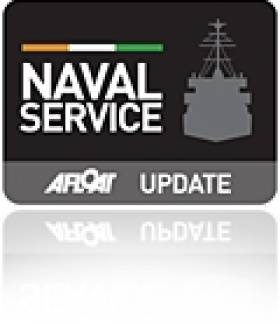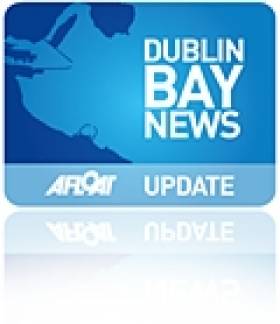Displaying items by tag: Dun Laoghaire Motor Yacht Club
The West Pier based Dun Laoghaire Motor Yacht Club is advertising marina berths as part of its membership package in the West Bight area of Dun Laoghaire Harbour.
The club caters for all types of craft and sailors, from serious sailors to those who just enjoy being out on Dublin Bay.
"With an already strong presence on the West Bight harbour, this additional service provides an exciting opportunity for our club to expand its membership base", DMYC Commodore Ian Cutliffe told Afloat.
"The club would like to extend an invitation to potential new members, including boat owners, to join, so if you are interested in joining the club, please get in touch with us on 01 2801371 or e-mail [email protected], Cutliffe says.
49er Skiff Among Dinghies Rolling in for DMYC Viking Marine 'Christmas Cracker' on December 27th
A wide variety of entries from regular Frostbite sailors and others are rolling in for the DMYC supported by the Dun Laoghaire Harbour Viking Marine Christmas Cracker, one of the few sailing events over the festive break, with a 49er potentially the fastest craft entered.
The wind forecast has dropped from a gusty 17kts to a cyclonic variable 3 – 5kts, potentially favouring a well-sailed GP 14 or IDRA 14 over the planing dinghies that need the power to reach optimum speeds.
As Afloat reported previously, this is a novelty Charity race in aid to the RNLI, with the aim of creating a spectacle for all those strollers on the piers.
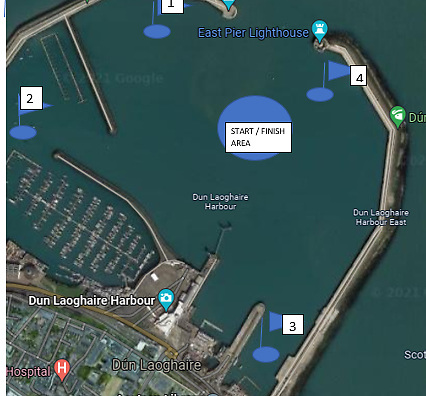 Viking Marine dinghy Christmas Cracker - The course as above, will feature marks in the extreme corners of Dun Laoghaire harbour
Viking Marine dinghy Christmas Cracker - The course as above, will feature marks in the extreme corners of Dun Laoghaire harbour
DMYC Organiser Neil colin told Afloat, "Currently, we are almost halfway to the 90 entry cap limit set, entries are listed on the DMYC website, alongside the entry form and a link to donate to the RNLI.
"We would like to encourage all entrants to decorate their craft, and wear festive attire, including the required buoyancy aids!"
"We are all set for 27th and look forward to this unique event. Happy Christmas!" Colin said.
Dun Laoghaire Motor Yacht Club Releases Winter Clubhouse Programme
#DMYC - The Dun Laoghaire Motor Yacht Club has a busy winter clubhouse programme ahead despite a slow start to the Sunday Frostbite series.
The flat calms and full-blown gales that have played havoc with the weekend sailing schedules as of late will have little effect on the November supper this Saturday 14 November at 7.30pm, nor the annual Christmas Dinner set for Friday 18 December, also at 7.30pm. Booking for both is available at www.dmyc.ie.
Other upcoming events include the new navigation class beginning this Friday 13 November at 7.30pm, running for four weeks. The Thursday Talks programme continues every week at 8pm (see the schedule on the clubhouse noticeboard for details), while Santa makes his visit for the club's younger members on Saturday 12 December at 12.30pm.
The DMYC has also announced its winter opening times, which will see the clubhouse office open Mondays from 10am to 1pm and Tuesdays to Fridays from 10am till 4.30pm.
Launch service is available Tuesdays and Thursdays from 10.30am to 4pm, and 10am to 5pm on Saturdays and Sundays.
Meanwhile the bar will be open on late Thursdays from 6pm till 11.30pm, Saturdays from noon till 8pm and Sundays from noon till 9pm.
DMYC Is 'Not For Moving' In Lease Dispute With Dun Laoghaire Harbour Company
#DMYC - The Dun Laoghaire Motor Yacht Club is "not for moving", the club's commodore has declared after its most recent AGM.
Commodore Barry Kenny was commenting on the DMYC's efforts to negotiate a new lease of the clubhouse and slipway in Dun Laoghaire Harbour since the previous long-term agreement expired in 2009.
"Although we continue to pay rent, the lack of a lease causes a degree of insecurity and makes it difficult to attract the much needed grant funds, which other clubs have secured," he writes in the latest club newsletter.
The most recent push "to bridge the gap and agree a lease along the lines established by Liam Owens when he was commodore" resulted in a lease from the Dun Laoghaire Harbour Company that was deemed "unacceptable in that it seemed based upon the proposition that the harbour company own our building."
Kenny adds: "These new terms were introduced without consultation, which will make good faith negotiations in the future difficult."
It is hoped that Dun Laoghaire-Rathdown County Council's moves to assume control of the harbour would bring clarity to the situation in the near future.
But in the meantime, as Kenny writes, "it is the intention of the incoming committee to take steps to assert our rights to our clubhouse and slipway."
In other DMYC news, the AGM on 4 November heard that the decline in core membership is "coming to an end" thanks to a significant influx of new members since 2014, most of whom renewed for 2015.
"New members, many of whom are boat owners, tend to be active whether they are racing or cruising, crewing or fishing in Dublin Bay," writes Kenny. "Many have added value to the club by volunteering or serving on committee, and this will stand to DMYC in the future."
The AGM agreed new membership rates in line with the wish to bring ordinary rates down and retain new members for the long term.
DMYC Dinghy Frostbite Racing Cancelled Due to Strong Winds
This afternoon's DMYC dinghy frostbite series has met the same fate as this morning's DBSC Turkey Shoot due to gale force winds on Dublin Bay. Racing continues next Sunday.
DMYC Cancels September Series Over Poor Participation
#Racing - The Dun Laoghaire Motor Yacht Club (DMYC) has cancelled its September Series for 2015 due to poor particpation, with only two boats entering the series.
In a statement, the club said: "We cannot in good conscience offer racing with that few boats, nor ask multiple volunteers to give their time."
In the series' stead, the DMYC will be running two Kish races, one for single- and double-handed boats (date to be confirmed) and another for fully crewed vessels scheduled for Sunday 27 September.
#inss – Last week, Sailing on Saturday featured the Royal Cork Yacht Club, the oldest in the world, as it comfortably donned the mantle of the ISA/Mitsubishi Motors Sailing Club of the Year 2015. This morning, we find ourselves involved with what may well be the newest sailing club in the world, the Irish National Sailing Club. It is certainly, thanks to being inaugurated nearly three months after Youghal SC was founded on 28th October 2014, the newest in Ireland. W M Nixon tries to explain it all as he finds himself in the world of Irish sailing's most complete dynamo.
Alistair Rumball is a Life Member of the Awkward Squad. Cage-rattling and pot-stirring are second nature to him. But it's not because of experiencing an unhappy childhood. On the contrary, while growing up in Malahide, his boyhood summers were bliss. He and his brother Arthur had as much sailing as they could want, fitted in between part-time jobs raising pocket-money with a morning picking potatoes at Dermot Dickie's farm along the Broadmeadow Estuary, followed by an afternoon of sailing the sea with the sun always shining, and then maybe an evening of club racing followed by the easy camaraderie among kids who are comfortable with boats.
It was an idyllic maritime environment which, over the years, has produced some of Ireland's top racing and cruising sailors. But while the young Rumball was no slouch on the race-course, the strongest feeling he had about sailing was the sheer fun of it all, the totally absorbing wonder of being in a boat and hauling on ropes to make sails change shape and help you along your chosen course over the always interesting sea.
Although he graduated from Trinity College Dublin as an engineer, he increasingly had this almost evangelical attitude to spreading the good news about the fun of sailing. And while he has something of a reputation – to say the least - for being confrontational, it's central to his contradictory character that he's an extremely good teacher. If somebody shows the slightest genuine enthusiasm about wanting to learn to sail, Alistair Rumball has been prepared to go to endless lengths to teach him or her to do so, and to do so with enjoyment.
Underlying that, we find the first of his gripes about the modern sailing scene. He reckons that it has become far too serious. Don't think for a moment, though, that he believes in a frivolous approach to boats and sailing. He's deadly serious about having everything just right as regards safety and function.
But once that's sorted, then he firmly believes that you should go out and enjoy it. He waxes lyrical about moments of sheer sailing ecstasy he has enjoyed in a wide variety of boats in many sailing locations worldwide. And whatever he may have formally set out to be in a professional career, his working life has been spent in and around boats, getting people introduced to boats and out afloat, sometimes on an almost industrial scale.
Time was when sailing skills were something you acquired by a sort of osmosis through family tradition, club opportunities, and friendship examples. That's mostly how Rumball himself learned to handle a sailing boat. But he seems to have this almost messianic zeal to teach people to sail, and he became convinced that the future lay in more structured training with a proper syllabus.
Having taken a long hard look at the population distribution of the Greater Dublin area and where they might best get afloat in worthwhile numbers, in 1978 he acquired the assets of a moribund organisation, the Dun Laoghaire Sailing School, and soon found himself giving his first lessons to two pupils using a fibreglass-clinker Darragh 14 knockabout sailing dinghy which they'd launched from the public slipway in the Coal Harbour in Dun Laoghaire. The long journey had started towards an organisation whose activities today today include top-of-the-line race training in 1720s in winning mode:
The majestic granite harbour of Dun Laoghaire was a cold place in 1978 for any young enthusiasts trying to set up an independent sailing school on a commercial basis. For the powers that be, sailing was something to be learned through family and clubs under the Junior Training Programme of the Irish Yachting Association. If you were a young person or adult from a non-sailing background but keen to learn, unless you'd an obliging and patient friend from within the sailing establishment, the expectation was that you'd take yourself off to somewhere far away like the Glenans Ireland bases in Baltimore and Bere Island and Clew Bay, and eventually reappear after a decent interval with enough experience, newfound ability and contacts to make the grade in the Dublin Bay sailing scene, where the very thought of a raw in-harbour sailing school for outsiders seemed distasteful to the establishment.
Yet hidden away in the southwest corner of Dun Laoghaire harbour, here was this gadfly of the sailing scene, Can–do Alistair with his rough and ready sailing school enthusiastically recruiting pupils anywhere and everywhere, and taking them afloat in boats which may not have been in the most pristine condition, and certainly set sails which would not be winners on the race course, yet they were safe and able, and so were he and his instructors.
Over the years, an entire cohort of people, mainly from Dublin but also from all over Ireland with a useful smattering of pupils from abroad, came to boats and sailing thanks to this wild-haired character whose love of his demanding work shone through everything he did.
Gradually the fleet expanded, and so too did the "Rumball Group's" activities, even though the very limited availability of premises on the Dun Laoghaire waterfront meant that every little square foot they had always seemed to serve at least three different purposes. But they were getting there, they opened a retail outlet in the town to sell boat gear and equipment which became Viking Marine, the school promoted itself to being the Irish National Sailing School, and they were well settled in place, using every inch of space on the ground floor of the interesting little building on the southwest corner of the harbour which used to be the Nautical College.

The man and his machines – Alistair Rumball and his chariot outside the Irish National Sailing School's HQ in Dun Laoghaire. Photo: W M Nixon
Centuries ago, seafaring education was given a significant role in Irish life in the late 1700s, the 1800s, and the early 1900s with the old Marine School a fine building on the south quays in Dublin. But its premises were re-allocated for development purposes and the school itself had its final home in Clontarf before being absorbed only as a vague memory into what is now Mount Temple Comprehensive school.
These days, the marine education focus has moved to Cork with the fabulous new National Maritime College in Ringaskiddy, but for that low period in Irish maritime life in the mid 20th century, one of the few keepers of the flame was Captain Tom Walsh who operated the little Nautical College in this fairly inconspicuous Office of Public Works building now hidden away behind the Dun Laoghaire Motor Yacht Club.

Captain Tom Walsh in teaching mode in 1957 in the INSS building when it was the Nautical College.

The 110ft barquentine which Jack Tyrrell designed for Captain Tom Walsh's Nautical College in 1954 in the hope that it would inspire the building of an Irish Tall Ship
It was the gallant Captain Walsh who in 1954 commissioned Jack Tyrrell of Arklow to design a 110ft sailing ship – a barquentine – to be Ireland's very own tall ship, our first sailing training vessel. God bless the good captain, but he was convinced that if he could just get someone in Government to see these inspiring plans, then such a ship would be on the way.
You can imagine just how far such a visionary idea travelled in the deadly dull Ireland of the 1950s. Far from getting a proper training ship built, Captain Walsh had enough trouble keeping his college in being. Yet he was a gentleman and enthusiast to the end, and after retirement he augmented his pension by testing compasses in yachts, which I remember well as he did it for me with a little cruiser in 1981. The only mutually convenient time it could be done was on a Saturday evening, and I'd to get the boat from Howth to Dun Laoghaire to do it, but the actual swinging of the compass by Tom Walsh was such a pleasant and educational experience that any thoughts of being at some Saturday night party were entirely banished.
So when you go into the main premises of the Irish National Sailing School today, it's natural to remember Captain Tom Walsh, and I like to think that he would thoroughly approve of the old building's current usage, for Alistair Rumball and his team are mighty busy during what must sometimes be an 18-hour day, and just this week – before the sailing season is really fully under way – Monday was typical, with 185 schoolkids bussed down from Maynooth for a day's coaching afloat, followed by all sorts of gatherings including a committee meeting of the newly-formed Irish National Sailing Club.
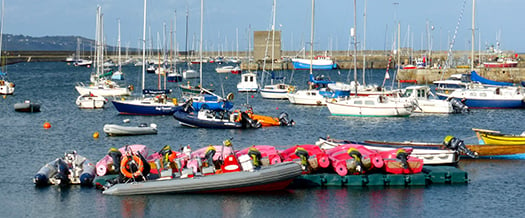
Space is so constrained that a floating dinghy park has to be used to store the smaller craft. Photo: W M Nixon
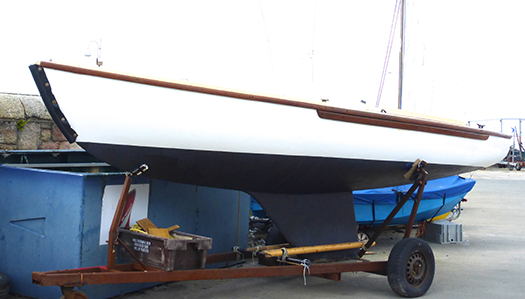
Thanks to the special INSS fendering devised by Arthur Rumball, this 35-year-old Squib has survived many seasons of tough teaching in good order. Photo: W M Nixon
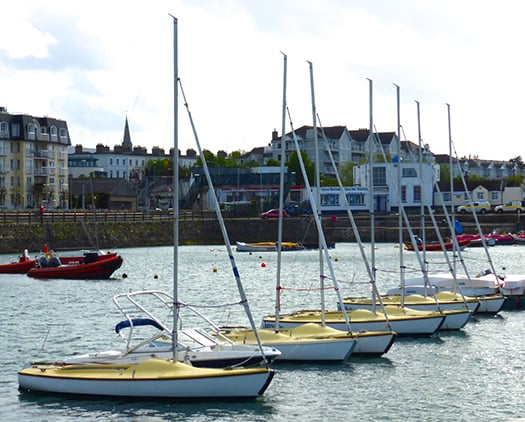
To economise on space, the Squibs berthed here, with the INSS building in the background, are double-moored. Photo: W M Nixon
Of which more anon, for this bare outline gives only a hint of the INSS's complex programme. The Rumball theme is that you have to keep operations and facilities flexible to cope with fluctuating demand, for at the height of the season the school is operating a fleet of 200 boats ranging from kayaks through sailing dinghies of increasing size, then on into keelboats of which some well-fendered Squibs are the workhorses while 1720s provide the glamour input, and finally at the top of the tree there's the Reflex 38 Lynx, bought from Galway this past winter, and becoming part of a programme headed by Alistair's son Kenneth – a Silver Youth Medallist in the 420 – who is now a fully-qualified offshore racing pro teacher, but also races the 1720s while being main operations director of a school which has five full–time employees, but in all has sixty staff at the height of the season.
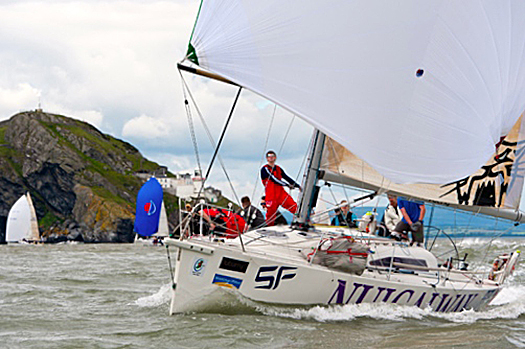
The latest addition to the INSS fleet is the Reflex 38 Lynx, seen here racing for NUI Galway during the Round Ireland. In 2015, Lynx has already scored a second overall in ISORA racing skippered by Kenneth Rumball.
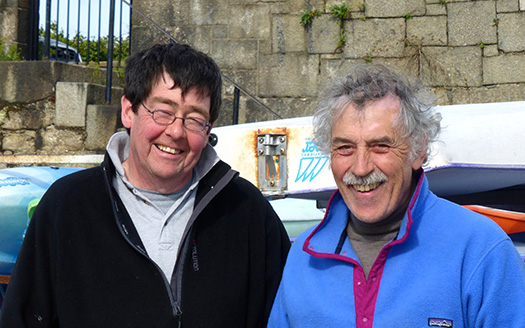
Brothers in business – seen here with his brother Alistair, Arthur Rumball (left) runs the often very busy INSS boat maintenance facility. Photo: W M Nixon
As to shoreside facilities, each summer they set up an additional seasonal summer base to the west of the West Pier with top-of the-line Portakabins at Salthill to provide facilities for those sailing dinghies and kayaks, and in addition the INSS have their own boat-maintenance unit under Arthur Rumball beside the boatyard in the Coal Harbour.
So an impressive amount of things have happened since 1978, the best of them surely being that Alistair persuaded Muriel, a country girl from one of the most beautiful parts of County Carlow, to marry him. For Muriel is a teacher by profession, and adept at being the peace-maker who smooths the waters after Alistair has been making waves, which even now still seems to be just about all the time.
That said, he gives the impression of having so many chips on his shoulder about the perceived opposition to his ventures by those in authority that you begin to think it might be just a bit of an act, for underneath it all he has a heart of gold, yet with the spirit of a lion who will fight the good fight to defend his territory and the interests of his family, friends, trainees and businesses.
The quality of the man was well revealed when the economic recession struck. At the height of the boom years, the Irish National Sailing School had a throughput of more than 2,500 people per month coming new to sailing, and it had become a vibrant and trendy part of the recreational fabric of good-time Dublin. Then around 2008, the economy went into free-fall. But the INSS survived both by making severe cutbacks in everything, and utilising another string in Alistair's bow.
Because of his ready enthusiasm to undertake just about everything and anything to do with boats, back in 1982 he'd looked after some waterborne scenes with classic small craft for the Channel 4 TV comedy-drama series The Irish RM, starring Peter Bowles and Bryan Murray, which went out between 1983 and 1985. It was grand at the time, but thirty years down the line it now seems to have a dose and more of the Paddywhackery about it. However, that was neither here nor there for Alistair Rumball in 1982, for it gave him a lucrative little sideline, and over the years since he has been the man to go to if you want to set up boats and sailing ship scenes in the Irish movie-making business.
So it's ironic, when we remember that Malahide was where the rather mouldy old Vikings of Dublin made their last base after their city had been captured by the Normans in 1171, that it should be a Malahide boy who has emerged as the behind-the-scenes captain of ships for the filming of the blockbuster series Vikings.

When you've spent most of your working life teaching people to sail, tutoring Thespian Viking crewmen on a Wicklow lake is just an ordinary part of another day at the office.
It has all been happening for some years now up in the Wicklow mountains and out on the Wicklow lakes, which have passed themselves off very well as Norwegian fjords, yet can double quite effectively as the coastal and riverside scenery of the many places where the Norwegian Vikings wreaked mayhem.
Who knows, but maybe with the passage of time the epic Vikings series will come to be seen as the epitome of Scandiwhackery, but for now, it certainly does the business . For as the Irish economy fell off a cliff, Alistair Rumball soared aloft in creating, managing, and manoeuvring a very authentic and substantial Viking longship flotilla which has provided a proper Tinseltown income to make all things possible, while helping underwrite the future of the Irish National Sailing School.
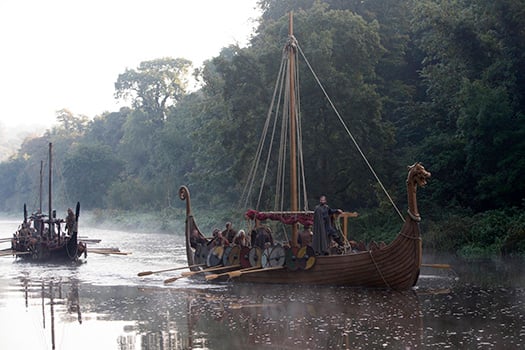
Lough Dan in County Wicklow - where Erskine Childers first sailed around 1890 – has proved remarkably versatile in providing backgrounds for the Vikings which could either be Norway itself, or else the shores of places they are raiding
But it's extraordinarily demanding and time-consuming work, even if he has a staff of 150 specialists up in the Wicklow hills, and after a year or two it became clear that he was trying to do too much. So four years ago his son Kenneth, who is now 27 and was at the time working as an accountant, moved in to take over the direction of the sailing school, and as the recession has started to recede – last year they had monthly numbers pushing back towards the 2,000 mark - Kenneth's energetic and all-encompassing input is seeing the school increasing the scale of its operations, particularly in what might be called the post-graduate side with the development of 1720s at top race level. Now the acquisition of Lynx has developed things further - she has already made what was a rather hasty debut in the first ISORA of the year, but despite being only minutes out of the box, they placed second overall, and that only by six minutes.
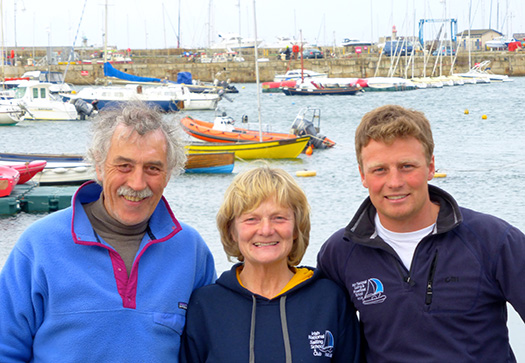
Alistair, Muriel and Kenneth Rumball. Photo: W M Nixon
This placing of racing as a natural part of the INSS syllabus has in turn led to the need for an officially-constituted club to comply with race entry requirements. But in reality the INSS has had a genuine club atmosphere for years, indeed it has more of a truly club-like atmosphere than many a historically-constituted old yacht club. So it was only a formality to bring the Irish National Sailing Club into being in January 201, but it's for real, here's a pic of the Committee of the new club meeting in the old Tom Walsh building on Monday, and if you want to join, it will cost you the outrageous sum of €10.
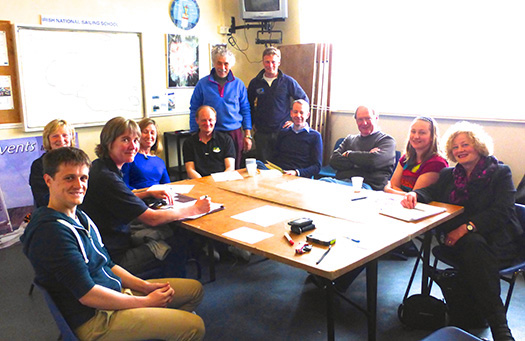
The committee and school management of the newly-formed Irish National Sailing Club are (left to right) Glyn Williams (foreground), Muriel Rumball, Joan Sheffield, Caroline Herron, Robin Jones, Alistair Rumball, Kenneth Rumball, Garrett O'Malley, Dermot Igoe, Heather Blay and Mary Beck. Photo: W M Nixon
As to how Alistair Rumball views the impending possible re-structuring of Dun Laoghaire as a cruise liner port, with inevitable limitations on the amount of sailing which can take place within the harbour, he is both an idealist and a realist.
Like many of us, he dearly wishes that this splendid granite creation could be seen as a cherished part of our heritage, not as something to be used to generate income to turn a crude profit or even just to pay its own maintenance costs. Rather, we'd ideally like to see it treated as a national asset to provide vital recreational space for everyone afloat and ashore.
But Alistair Rumball senses that the government's determination to use just about everything in public ownership to generate income will win the day, and he is already being realistic about what the regular if summer-emphasised arrival of cruise liners will mean.
In fact, he may even derive a certain sardonic satisfaction from seeing the Dun Laoghaire sailing establishment having to contemplate accepting conditions with which his school has complied ever since he began operating it.
"People should realise" he asserts, "that there are already two clearly-define shipping channels in Dun Laoghaire Harbour. One is from the harbour entrance to St Michael's Wharf, which will simply be retained if the cruise liners come. The other, much less widely known, is supposed to be from the harbour entrance to the berth at the Band Stand on the East Pier. Even at present, you are not meant to operate under sail in either of those channels, but an awful lot of boats do so."
"However, as we are a commercial operation, we have a strict policy of complying with regulations and carrying out our sail training and teaching operations in the western part of the harbour, clear of the main channel. So a cruise liner should not affect our in-harbour activities, while our larger craft going out into the bay will have to comply with shipping regulations in the entrance like everyone else".
Whatever happens, we may be sure that the Irish National Sailing School and the Irish National Sailing Club - and their splendid founder - will continue to be a thorn in the side of those who take themselves too seriously and have an inflated idea of their own importance. But if you've never been in a boat before and know nobody in sailing, yet feel a growing enthusiasm to go sailing in Dun Laoghaire, you now know where to go to experience the real thing.
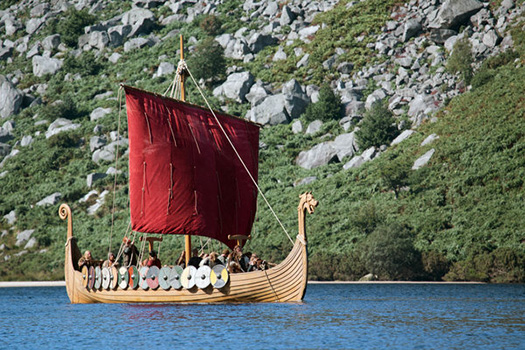
The other side of the INSS show – a Viking ship looking good on Lough Dan
Frostbite Prize-Giving Closes Proceedings in Dun Laoghaire
#fireball – The 44th hosting of the Frostbites by Dun Laoghaire Motor Yacht Club was brought to a close yesterday with the prize-giving for the Series taking place in the clubhouse.
Racing had been programmed for the day, but an adverse forecast, which manifested itself with a very windy seascape saw the racing cancelled by Facebook notification late in the morning and N over A flying from the clubhouse flagpole.
DMYC Commodore, Kevin Burke, opened proceedings by recording a vote of thanks on behalf of DMYC and the competitors to Olivier Proveur for the successful completion of another Series and for the time and effort he puts in to organising the Series.
Kevin also advised the audience gathered in the clubhouse that DMYC is celebrating its 50th anniversary this year and indicated that there will be a variety of celebrations throughout the year. Additionally, on the weekend of 27/28 June, the club will host a celebratory regatta in tandem with Dublin Bay Sailing Club who manage the racing on Dublin Bay over the summer months. In his closing remarks, Kevin drew attention to the range in age of the Frostbite participants – from Olivier's 12-year old son, Oisin, to Louis Smyth in the Fireballs.
Olivier took over the microphone from Kevin and said how pleasing it was to see the Frostbite fleet grow again this year. Involved since 2000, when he took over from Valerie Kinnear, Olivier advised that this year the Frostbites had an entry of 103 boats in total. This year a number of changes had been implemented resulting in four separate starts. He suggested that the weather had not been as kind to them as in recent years with only 18 races completed – not 18 Sundays. Series 1 had only five races, from the first Sunday of November to the last Sunday before Christmas. He also asked the competitors to acknowledge the volunteer core of the Frostbites and proceeded to list 18 people ranging from the Race Officer, Kevin Cullen, through timekeepers, recorders, mark-layers and rescue personnel. Two people were given special mention – Dave Coleman (Fireballs) who hadn't missed a single Sunday of the Series as a rib driver and Bob Hobby who, in addition to mark-laying duties posted photographs of each Sunday's proceedings to Facebook. Photographs from the Frostbites have been viewed by 3,460 people. The closing thanks went to DMYC's boatman Richard who prepares all the equipment for each Sunday's racing and Fiona and Carlos in the clubhouse who look after everyone post-racing with soup and a bar service.
The prize-giving then took place with two sets of prizes for each class – Series 2 and the overall Series. For the Fireballs Series 2 was another close run affair for the first two boats overall. As the individual reports for the races have advised, the distance between Messrs Butler and Rumball was never very much apart from one exception that comes to mind. They seemed to be in a constant state of watching out for the other boat!
DMYC Frostbites: Series 2; 13 Races sailed, 3 Discards.
1 Noel Butler & Stephen Oram 15061 National Yacht Club &
DMYC. 15
2 Kenneth Rumball & Brian Byrne 15058 Irish National Sailing Club 17
3 Neil Colin & Margaret Casey 14775 Dun Laoghaire Motor Yacht Club 45
4 Frank Miller & Grattan Donnelly 14713 Dun Laoghaire Motor Yacht Club 47
5 Louise McKenna & Hermine O'Keeffe 14691 Royal St. George Yacht Club 52
In terms of the overall Frostbite title, the gap between the first two boats was a bit more pronounced, courtesy of a perfect Series 1 for Rumball & Byrne that saw them undefeated over the five-race series. And this performance is what probably set them up for the overall title.
DMYC Frostbites; Overall; 18 Races sailed, 5 Discards.
1 Kenneth Rumball & Brian Byrne 15058 INSC 17
2 Noel Butler & Stephen Oram 15061 NYC/DMYC 23
3 Conor & James Clancy 15113 RStGYC 58
4 Neil Colin & Margaret Casey 14775 DMYC 61
5 Frank Miller & Grattan Donnelly 14713 DMYC 62
The 1-2-3 overall received plaques which made reference to the 50th anniversary of the DMYC.
On completion of the prize-giving, Pat Shannon and Jonathan O'Rourke of the Dublin Bay Sailing Club give a very short presentation on DBSC's plans for the summer's racing – new classes/starts, new courses, more midweek races and a plan for 18 nights of Tuesday racing and 20 Saturdays of afternoon racing. There is an undertaking to provide more races with quicker turnaround times between races. Entry fees for the DBSC have been reduced and online entry will now be accessible. DBSC gets underway on 23rd April 2015.
For the Fireball fleet, there is now a break from the on-the-water activities. A class rule change allows for the removal of 3kg of lead weight corrector form the boats and this has resulted in the Irish Class setting up a "weighing day" for the fleet on 18th April. The consequence of this activity is that boats will have to be stored under dry conditions in advance of the weigh-in. A separate notification has gone out from the committee in this regard. Immediately after this session, we have a UK Fireballer undertaking a coaching session, the following weekend, April 25/26th.
Summer regattas are scheduled for May (Skerries), June (Cushendall), July (Dunmore East), September (Lough Ree) and October (Dun Laoghaire). Interspersed with these Class events there is the Volvo Dun Laoghaire Regatta (9 – 12 July) and the Fireball Worlds (15 – 30 August, Pwllheli, Wales, with an International Week beforehand). Fireballers should also be aware of a Dinghy Week type event in Cork from 21 – 23 August.
#dmyc – Dominic O'Keefe's Graduate, a J80 class yacht, was the IRC winner of class 2 in the Dun Laoghaire Motor Yacht Club's (DMYC) Summer Regatta on Saturday. Second was William Despard's Blakc Sheep from the National Yacht Club. The regatta attracted a strong turn out in most classes despite a clash with the 36–boat Round Ireland Race from Wicklow.
In the dinghy classes, two more Royal Irish sailors took honours in the single–handed Laser class. Paul Keane won from Justin Maguire in a four boat fleet over two races.
In the eight boat Ruffian class, Michael Cutliffe was the winner of a two race event from Frank Bradley's Ripples, both of the host club.
Regatta results supplied by DMYC are downloadable below as a zip file. The results can be opened with ms word, notepad or wordpad
Dun Laoghaire Dinghy Frostbite Series Falls Victim to Winter Gales Again
#frostbites – It my have been sailing as usual in Kinsale yesterday but the Frostbites in Dun Laoghaire Harbour fell victim to adverse weather again with strong gusty winds initiating the flying of "N over A" from the yard-arm of the Dun Laoghaire Motor Yacht Club (DMYC). Yet again, the forecast was foul for both Saturday and Sunday with Met Eireann predicting up to Force 10 for Saturday moderating to Force 6 to 7 on Sunday. XC Weather wasn't offering anything more attractive!
What made the conditions deceptive was that it was bright with a blue sky over Dublin Bay. However, the first tell-tale sign that sailing was in jeopardy was when I came out of Foxrock Church on Sunday morning and couldn't see any keelboats out. A quick visit to the harbour revealed that the wind was whistling in the rigging – never the most comfortable sound in the dinghy park.
A quick consultation with my helm, Louis Smyth, by phone saw us agree that racing would be a marginal call and so we decided that we would exercise the option of watching rugby from Paris.
A second visit to the harbour later in the afternoon revealed the "N over A" scenario but by that stage the conditions were more favourable – so much so that training sessions for Optimists and Laser Radials were underway inside the harbour.


























